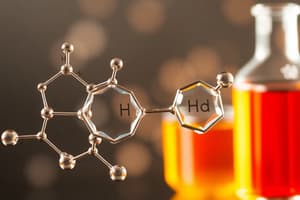Podcast
Questions and Answers
What is the chemical representation of a soap molecule?
What is the chemical representation of a soap molecule?
The chemical representation of a soap molecule is RCOONa, where R = non-ionic hydrocarbon group and −COO−Na+ ionic group.
What is the common name for the alkaline hydrolysis of oils and fats?
What is the common name for the alkaline hydrolysis of oils and fats?
The common name for the alkaline hydrolysis of oils and fats is saponification.
What are the products formed when ethanoic acid reacts with a solution of sodium hydroxide?
What are the products formed when ethanoic acid reacts with a solution of sodium hydroxide?
The products formed when ethanoic acid reacts with a solution of sodium hydroxide are sodium ethanoate and water.
What gas is liberated when ethanoic acid reacts with metals like sodium, zinc, and magnesium?
What gas is liberated when ethanoic acid reacts with metals like sodium, zinc, and magnesium?
What gas is evolved when carboxylic acids react with carbonates and bicarbonates?
What gas is evolved when carboxylic acids react with carbonates and bicarbonates?
What does the IUPAC system of nomenclature correlate the name of a compound to?
What does the IUPAC system of nomenclature correlate the name of a compound to?
In the IUPAC nomenclature system, what does the root word indicate?
In the IUPAC nomenclature system, what does the root word indicate?
What is the primary suffix for compounds in the IUPAC nomenclature system with single bonds only?
What is the primary suffix for compounds in the IUPAC nomenclature system with single bonds only?
What does the prefix in the IUPAC nomenclature system indicate for organic compounds?
What does the prefix in the IUPAC nomenclature system indicate for organic compounds?
According to the IUPAC system, what does the name of an organic compound consist of?
According to the IUPAC system, what does the name of an organic compound consist of?
Flashcards are hidden until you start studying
Study Notes
Soap Molecule Representation
- Soap molecules typically have a long hydrophobic tail (hydrocarbon chain) and a hydrophilic head (ionic or polar group).
- The general formula for a soap molecule is RCOONa or RCOOK, where R represents the hydrocarbon chain.
Alkaline Hydrolysis of Oils and Fats
- The process is commonly known as saponification.
- Saponification results in the formation of soap and glycerol from triglycerides and an alkali.
Reaction of Ethanoic Acid and Sodium Hydroxide
- When ethanoic acid (acetic acid) reacts with sodium hydroxide, the products formed are sodium ethanoate (sodium acetate) and water.
- This reaction is classified as an acid-base neutralization.
Gas Liberated from Ethanoic Acid and Metals
- Ethanoic acid reacts with metals like sodium, zinc, and magnesium to liberate hydrogen gas (H₂).
- The reaction typically involves the acid donating a proton (H⁺) to the metal.
Gas Evolved from Carboxylic Acids and Carbonates
- When carboxylic acids react with carbonates or bicarbonates, carbon dioxide (CO₂) gas is evolved.
- This reaction also results in the formation of a salt and water.
IUPAC System of Nomenclature
- The IUPAC system relates the name of a compound to its structure and functional groups, providing clarity in chemical communication.
- Names reflect the molecular composition, including the types of atoms and their arrangement.
Root Word in IUPAC Nomenclature
- The root word indicates the number of carbon atoms present in the longest carbon chain.
- Common root words include "meth-" for one carbon, "eth-" for two, and "prop-" for three.
Primary Suffix in IUPAC Nomenclature
- The primary suffix for compounds with only single bonds is “-ane.”
- This indicates that the compound belongs to the alkane group (saturated hydrocarbons).
Prefix in IUPAC Nomenclature
- The prefix in IUPAC nomenclature specifies the presence of substituents or branches in organic compounds.
- Examples include "iso-" for isomeric forms and numerical prefixes like "di-", "tri-" for multiple substituents.
Structure of Organic Compound Names in IUPAC
- The name of an organic compound consists of a prefix (indicating substituents), a root (indicating carbon chain length), and a suffix (indicating the type of functional group).
- This systematic approach ensures uniformity in naming across various chemical compounds.
Studying That Suits You
Use AI to generate personalized quizzes and flashcards to suit your learning preferences.




